Your Complete Guide to Indoor Plants: How to Keep Them Happy, Healthy and Green (original) (raw)
Some people are convinced they’re born with a brown thumb. But the truth is, anyone can become a successful plant parent. Not only is it possible to make your indoor plants flourish, but taking care of them can also be fun. “Once new indoor gardeners have a better understanding of where a plant should live, how to water it and how much light it needs, that will boost their confidence that they can make them thrive,” says horticulturalist Anil Chandrakumar, a garden coordinator with the New York City Parks Department. In fact, when that happens, you may even end up thinking that houseplants are better than dogs. (Really!)
Of course, houseplants spruce up your space, but they also make your home a better place. Air-purifying plants can help improve your air quality, an indoor herb garden can add flavor and nutrients to your meals and flowering plants can perk up your mood instantly. You can even grow medicinal herbs to help relieve common ailments. Plus, adds Chandrakumar, “having nature in the room with you makes you more connected to the outside world.”
Whether you’re a newbie looking for low-maintenance indoor plants or low-light houseplants that are easy to keep alive, or you’re a more advanced gardener who wants to expand your knowledge, you’re in the right place. From the basics of plant watering and the best places to buy plants online to how to decorate with plants, maximize space with vertical gardens and get rid of pest infestations, we’ve got all the advice you need to keep your plants happy for years to come.
Get _Reader’s Digest_’s Read Up newsletter for more gardening advice, cleaning, travel, tech, humor and fun facts all week long.
ⓘ
On This Page
Toggle
- The best houseplants for every space and situation
- How to decorate your space with indoor plants
- How to care for your indoor plants
- How to care for popular indoor plants
- How to treat common houseplant problems
- The accessories your plant needs to thrive
The best houseplants for every space and situation
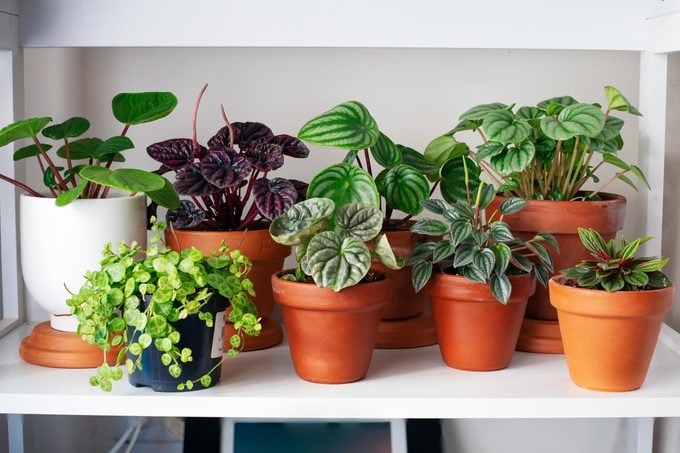 Rhisang Alfarid/Getty Images
Rhisang Alfarid/Getty Images
The best indoor plants are the ones that suit your aesthetic preferences and aren’t too difficult to maintain. That’s going to look different for everyone—and it’s all part of the indoor-gardening adventure. Indoor plants come in all sizes, shapes and even colors, but not every plant works in any spot or for everyone’s personal situation. Here’s what you need to know about these different categories of houseplants, so you can choose the ones that work best in your own home. Also, check out these best indoor plant pots and planters to house your growing greenery.
Low-light indoor plants
Not every home has a sunny atrium or a large bay window for plants to soak up the sunshine. And to be honest, the rooms that don’t have much sunlight are probably the ones that could use a little more flair anyway. Fortunately, there’s a large variety of plants that aren’t die-hard sun-worshippers.
Whether you have a dim corner that’s crying out for a little greenery or you’re craving some color in your bedroom, the best low-light indoor plants—many of which are also low-maintenance plants—don’t require a lot of time or energy.
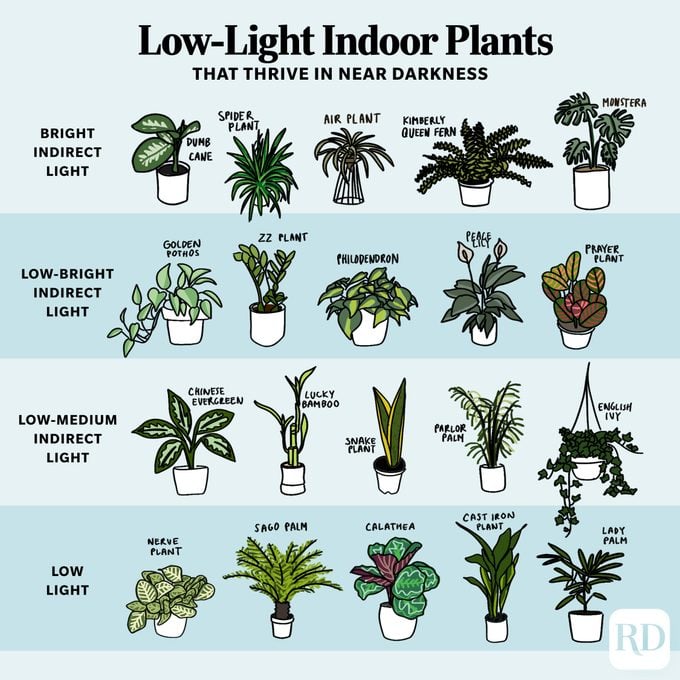 Grace Luxton/rd.com
Grace Luxton/rd.com
Tall indoor plants
Small succulents are delightful additions to your decor, but if you really want to breathe life into your home, grow a collection of tall indoor plants. “Tall houseplants can instantly bring a space to life by adding definition and texture to any home-decor style,” says Lindsay Pangborn, a gardening expert at Bloomscape.
Working with limited space? Not a problem. You can still make the most of tall indoor plants. Even just one of them can be a striking visual point for a room, and it can help draw the eye upward, making the room appear larger.
Small indoor plants
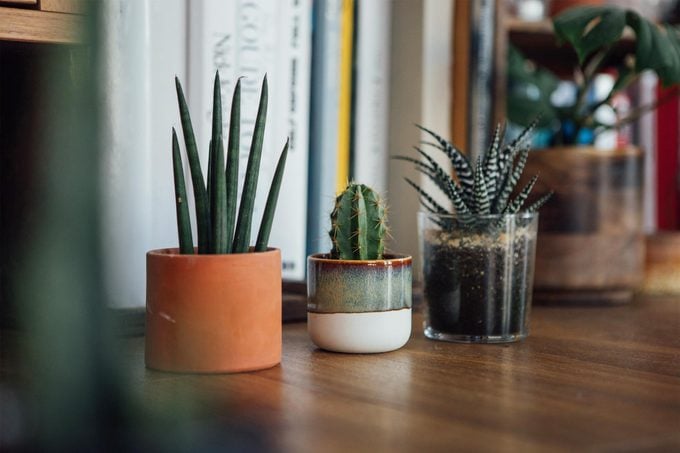 Oscar Wong/Getty Images
Oscar Wong/Getty Images
Just because you don’t have a mansion doesn’t mean you can’t have a lush indoor garden. There are plenty of plants that thrive in smaller spaces, the teensiest of which can look adorable clustered together like a tiny family on a windowsill or shelf. This is a great option for aloe and other sturdy succulents, as well as leafy beauties like pothos and peace lilies.
Keep in mind, however, that the smaller the pot is, the quicker the soil will dry out. It’s important to observe how quickly indoor plants dry out when you first bring them home, so you can come up with a smart watering schedule, says Chandrakumar. Here are some of our favorite small indoor plants for any home, from a studio apartment to a country cottage.
Indoor hanging plants
What makes indoor hanging plants so special? They fill a blank space in a room with a beautiful silhouette, for starters. Other people have different ideas of why they’re so appealing. “I think it’s the naturalness of them,” says Chandrakumar. “They create the illusion of a jungle, where plants peek out at different heights.”
They also move the eye upward, opening up the space. “A big part of garden design is vertical lines,” says Chandrakumar. “When all your plants are low, they can get lost. Having plants on eye level helps us feel at home in the room.”
Cat-safe plants
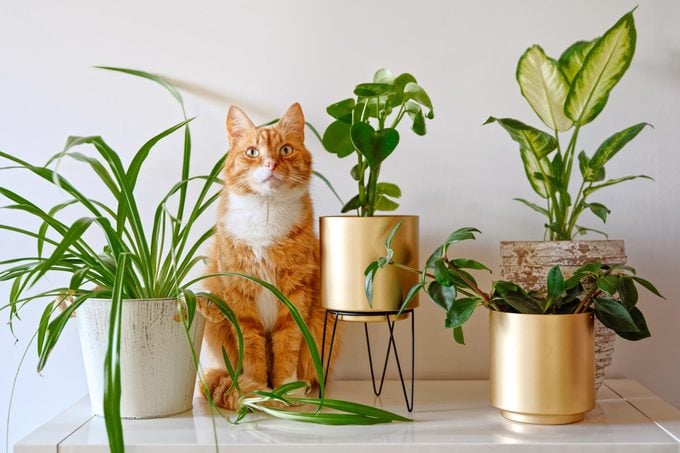 Damian Lugowski/Getty Images
Damian Lugowski/Getty Images
We all know that cats are curious creatures, and it can be hard for them to resist the urge to snoop around your houseplants. “A lot of cats want to chew on plants,” says Chandrakumar. If you’re a pet parent, you shouldn’t let them do that. According to the ASPCA, the consumption of any plant material may cause vomiting and gastrointestinal upset for cats.
And then, of course, there are the plants that are poisonous to cats. It’s important to double-check whether an indoor plant is toxic before bringing it into your home—or if you have these toxic plants in your house already.
Dog-safe plants
Unfortunately, some of the most popular indoor plants are poisonous to dogs, from sturdy snake plants to brightly colored tulips. With advice from veterinarians, we’re calling out the most common problematic plants so you can avoid or get rid of them—and providing options for dog-safe plants that are equally beautiful.
If you suspect that your pooch has eaten a poisonous plant, consult your vet immediately, or call the Animal Poison Control Center at 888-426-4435 for guidance.
How to decorate your space with indoor plants
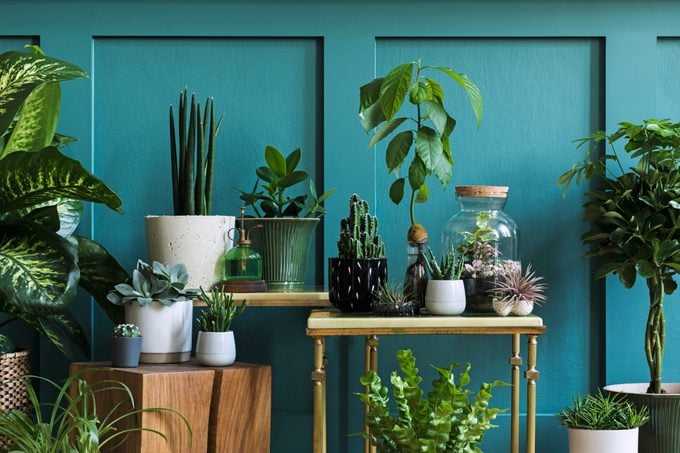 FollowTheFlow/Getty Images
FollowTheFlow/Getty Images
Plants and flowers are nature’s prettiest decor, so why not bring that decorating inspiration inside? Even if you’re not an interior designer, plants make it simple to spruce up a room. Bring one home, place it in the right showcase spot, and things instantly look better. And if you decide to grow a collection of them, they can have an impact on a larger area. “Plants soften up the interior of a room,” says Chandrakumar, which makes your place feel more homey. No matter which room you’re looking to beautify, here’s how to decorate with indoor plants.
How to care for your indoor plants
Plant care is the part of indoor gardening that intimidates new plant owners the most. More often than not, it’s fussing over plants—rather than ignoring them entirely—that trips up new plant parents. “As we used to say in botany school, there’s such a thing as loving your plants too much,” says Chandrakumar.
Much like people, indoor plants have individual personalities. The amount of water and light a houseplant needs will depend on the type of plant you have. Cactuses need less water than ferns, for example. And flowering plants generally like more light than their nonflowering friends.
To keep all your plants generally happy, Chandrakumar think’s it’s important to follow a basic gardener’s checklist. “If you do these things right, you should wind up with a green thumb,” he says.
- Put a plant where it gets at least six hours of sunlight.
- Deeply soak your plant with water without watering it again until the soil has begun to dry out.
- Keep a spray bottle on hand to mist the plant, particularly in winter, when it’s drier inside.
- Check up on your plant every so often to see if the roots are bound and if it needs a larger pot, as well as to remove dead leaves.
Water them just enough
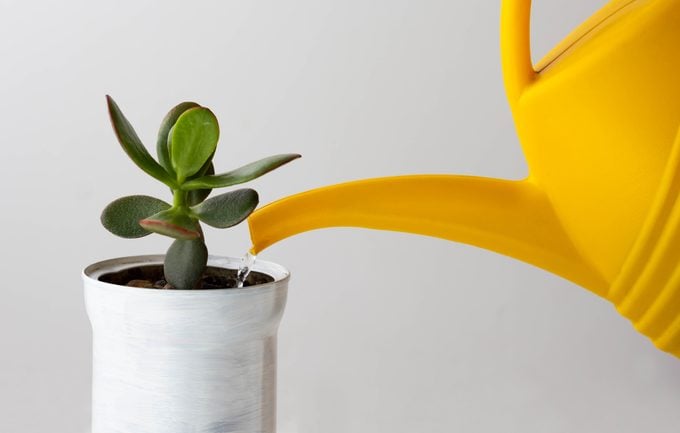 Tatiana Foxy/Getty Images
Tatiana Foxy/Getty Images
“The difference between having a brown thumb and a green thumb is the amount of water you give [your plants],” says Chandrakumar. “You want a deep soaking, but you can’t do that too often.” If you water too much, that can lead to problems like root rot. And if you water too little, you’ll probably wind up with a dead plant.
To help determine when your plant is ready for another drink, keep an eye on the color of the soil. “If you pour in another cup of water when the soil is still dark from the last time you watered it, you are drowning the plant,” Chandrakumar says. Here are more smart tips for plant watering.
Give them the right kind of light
We often get hung up on watering our plants and forget one of the other essential elements of plant growth: exposure to light. Even if you’ve devised the perfect watering schedule, you’ll still end up with a sickly plant if you don’t pay attention to this part of the equation. Whether you have a low-light indoor plant, like a philodendron, or a dwarf citrus tree or other indoor fruit tree that loves bright conditions, follow these lighting tips to help your indoor plants grow and flourish.
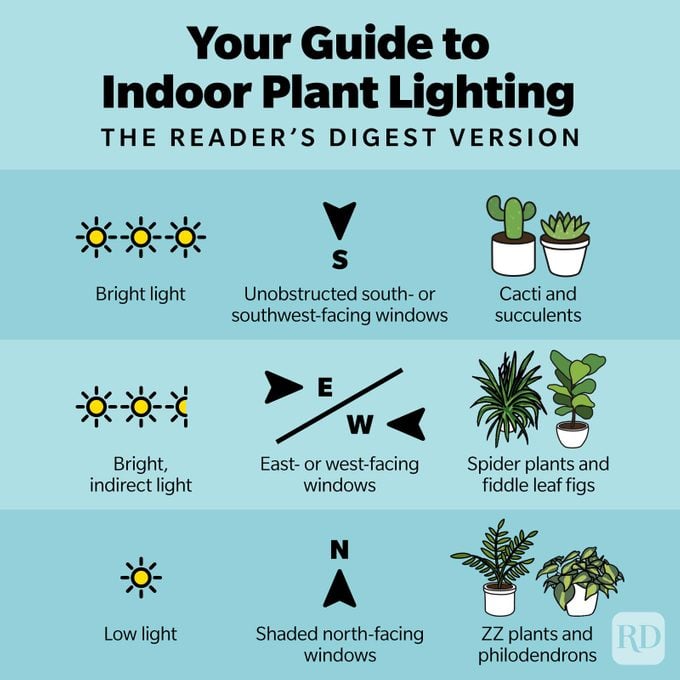 RD.com, Getty Images (4)
RD.com, Getty Images (4)
How to care for popular indoor plants
Snake plant care
Beginners, rejoice! Snake plants are incredibly low-maintenance plants that can handle a little (or even a lot) of neglect. While experts say they do best in full sunlight, they do just fine in low-light conditions, so you can really put them anywhere. They also don’t need to be watered frequently—and, in fact, they can go months without a drink.
Fiddle leaf fig care
These stunning leafy greens require a bit more care, mainly because they’re tropical plants that thrive in warmth and high humidity. They’re also a little finicky when it comes to their light preferences: Full sunlight is too much, while low light is too little. Instead, this Goldilocks plant does best in indirect bright sunlight near a south-facing window. For water, soil and fertilizer requirements, check out our guide to fiddle leaf fig care.
Spider plant care
While not hard-core sun-worshippers, spider plants need at least three hours of direct sun in a window. But they’re not picky about humidity levels, and if you give them a drink once a week, they’ll be happy. These low-maintenance plants make great hanging plants, with their draping, narrow leaves, but they can also do well on a windowsill. They even create their own “babies” so you can have a whole spider plant family in your home if you learn how to transplant them to their own pots.
Here’s how to care for some other indoor favorites so they live long, happy lives in your home.
How to treat common houseplant problems
Even the best of indoor gardeners have trouble with a houseplant from time to time. One of the first telltale signs of a problem? The leaves start to turn yellow. “You think the plant is dying, so you water it more or cut it back too dramatically, and that’s not going to help the situation,” says Chandrakumar.
Believe it or not, waiting it out may be a better course of action—particularly if the fussy plant is new to your home. “Sometimes we need to allow time for the plant to adapt to a new environment,” says Chandrakumar. “If your new plant is dropping leaves or they are turning yellow, it’s probably just adjusting to its surroundings,” he says. And brown tips on leaves may be a sign you’re not watering your plant enough. Give it a week or two to settle in before taking any drastic action.
On the other hand, time doesn’t heal all wounds. When it comes to common houseplant pests and root rot, you need to take action—fast. Here’s what you need to know.
Houseplant pests
There’s little that’s more unwelcome in your home than an insect infestation. Unfortunately, infestations are more common than you might think and can happen when creepy-crawlies hitch a ride on a new plant you bought or even on your clothing. But don’t let the thought of them deter you from growing a beautiful indoor garden. Remember: You are bigger than they are.
The good news is that although they’re a nuisance, most houseplant pests aren’t dangerous to humans or pets. They’re also generally easy and cheap to get rid of. Here’s what you need to know to take care of these critters.
Root rot
Remember the idea that you can love your plant a little too much? Well, root rot is what happens when you show your love with too much water. Caused by fungal and other related disease-causing organisms (but not white fungus balls) that enter a plant’s roots, these pathogens gain a foothold when roots sit in overly soaked soil. We have all the details for how to prevent root rot and save your affected plants.
The accessories your plant needs to thrive
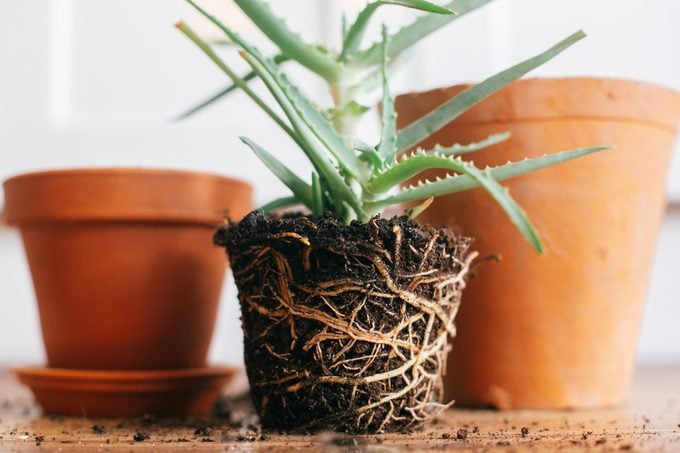 Bogdan Kurylo/Getty Images
Bogdan Kurylo/Getty Images
Just like humans, plants look better with accessories. Unlike knickknacks that just sit on your shelf, our potted friends grow and change over time. That means you’ll likely need to update or upgrade the pots, hangers or stands that you picked up when you first brought your plant home. Or if you just bought a new plant, it may still be in its plastic container and needs a permanent and pretty container to thrive in.
Ready to upgrade a beloved plant to a new, larger home? Here are the best indoor plant pots for you to choose from. Need a perch for one of your favorites that’s grown a little longer than when you first met? You might want one of these plant stands instead.
And if your love of indoor gardening has now become too infectious not to share, you can spread the green joy with friends and family with the best plant subscription kits. Make sure to share this guide to caring for indoor plants while you’re at it!
Sources:
- Anil Chandrakumar, garden coordinator with the New York City Parks Department
- Lindsay Pangborn, gardening expert at Bloomscape